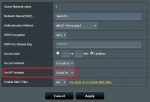cooloutac
Very Senior Member
I think whats happening here is Asus is responding to criticism that their vlans didn't properly isolate even with ap isolate on. Adding different subnets helps with this, contrary to what you believe, and there is probably something wonky going on with the allow intranet. This is why Yazfi addon allowed to do this and I think asus is taking the hint. But It is obviously not routing between the different subnets, so the only solution as bbunge said is to use guest 2 or 3. You can petition asus to fix it, but I personally would rather they didn't for security reasons lol. Maybe you need a more advanced router for your purposes.
But Again, it makes no sense to use a guest network with intranet enabled unless a timeout period is set. Or intranet is enabled only temporarily to allow some functions and you will again disable it.
But Again, it makes no sense to use a guest network with intranet enabled unless a timeout period is set. Or intranet is enabled only temporarily to allow some functions and you will again disable it.
Last edited:






